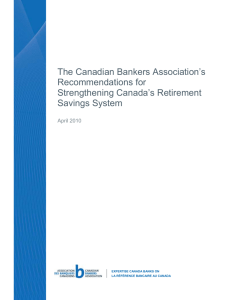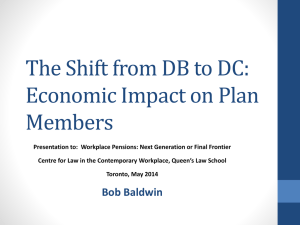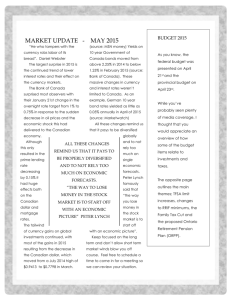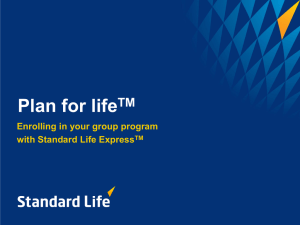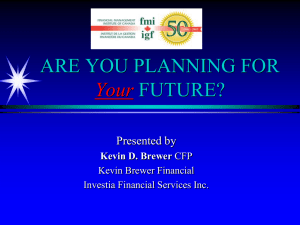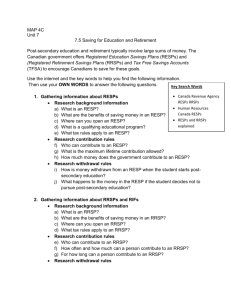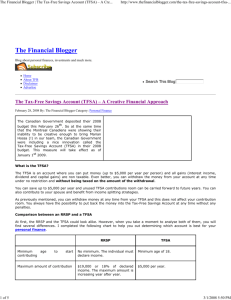Financial Basics for Senior Artists
advertisement
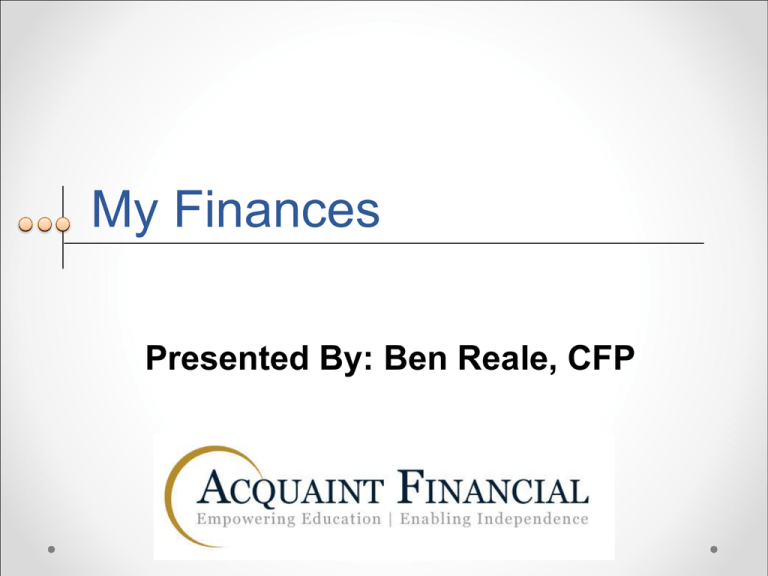
My Finances Presented By: Ben Reale, CFP Why should we budget? Those ‘must-haves’ Those unforeseen events along the way! Education expenses Home of your dreams Paying bills Ahh.. Retirement! ‘Reasons’ not to budget • • • • I spend everything I earn Budgeting is boring, tedious and never works Only rich people budget, I don’t make enough Are you kidding? – Living expenses, clothing, entertainment & gifts – Kids, tuition & books, transportation – There’s nothing left to budget! Regular vs. Periodic expenses • Regular Expenditures – Rent, transportation & food – Schooling costs • Periodic Expenditures – Clothing & gifts – Entertainment & repairs Non-discretionary expenses • • • • • Groceries Mortgage & rent Transportation Taxes Health care Discretionary expenses • Type of transportation you have – Car vs. public transit • Type of food you eat – Red Lobster vs. Tim Hortons • Dining out vs. brown bag • Hobbies • Entertainment – Rent a movie vs. $75 movie night This is what your budget might look like: Negative cash flow • Can I reduce spending? – Eat out less? Go out less? • Can I increase cash flow? – Part-time job? Sell items no longer used? • Do I need to change my lifestyle? – Move into a cheaper home? Sell my car? Managing debt • Clear balance on high interest debts such as credit cards monthly • After minimum payments, apply additional payments to move expensive debt first • Can you consolidate to reduce interest? • Use unexpected cash to pay down debt – Gifts, bonuses, rebates, refunds, overtime, etc. Debt Service Ratios • Ratios are used by lenders to assess your ability to repay the money they loan you. • Gross Debt Service Ratio (GDSR) – Mortgage, heating, taxes, 50% of condo fees – Not to exceed 32% • Total Debt Service Ratio (TDSR) – Gross debt + minimum payments on other debt – Not to exceed 40% Budgeting tips • Have one! But set realistic goals • Estimate future cash crunches and know how you will make up the short-fall • Understand that frugal living today means more enjoyment tomorrow • If you have a partner, involve them in the planning process Will you have enough? Two key questions Life Expectancy – How long does your money need to last Income Replacement Ratio – What percentage of your pre-retirement income do you require Income replacement ratio Source: Statistics Canada Pre-Retirement Income • $20,000 - $29,999 • $30,000 - $39,999 • $40,000 - $49,999 • $50,000 - $69,999 • $70,000 plus Replacement Ratio • 62% • 60% • 59% • 56% • 45% Retirement income example Non registered income • Value of a fund grows from $10,000 to $20,000 • You redeem $1,000 • 50% of the gain is taxed (50% of $500 or $250) • Tax is approximately $125 (assuming 50% tax bracket) • After tax is $875 Pension income • $1,000 of pension income • Fully taxable • Tax is approximately $500 (assuming 50% tax bracket) • After tax is approximately $500 Can’t meet your retirement income needs? • Save More: STEW! – Trade off some of today for more tomorrow • Take Less – Realistic estimate of retirement needs • Earn More – Higher returns on investments? – Efficient tax planning yields more after tax income • Work Longer – Maybe one day per week in retirement? Understand the basics • Canadian tax is progressive • Though there are exceptions, tax is generally logical • The government provides incentives and impediments to encourage and discourage various patterns • Taking advantage of incentives is not illegal • Taxes can be reduced through proper planning • Income can be split to reduce total taxes payable • Taxes can be deferred to create advantages • Know your rights as a taxpayer, and exercise them Federal & Provincial tax rates RRSPs – What’s the big deal? • Allows you to reduce your taxable income • Allows tax free growth • Excellent tool for saving for retirement Saving $10,000 for 10 years at 10% growth $238,986.48 Inside $136,565.52 The advantage is more than all of my deposits. Outsid e • Do Canadians take advantage of this opportunity? *Assumes tax rate of 40% with refunds reinvested How the TFSA works • $5,000 per year for each person over 18 • No maximum age limits (i.e. RRSP age 71) • No deduction or credit on contributions (i.e. RRSPs) • No tax on growth • No tax on withdrawals • No tax benefits on any losses • Contribution room is carried forward indefinitely • Contribution room is not reduced by withdrawals • Withdrawals do not affect income tested programs – GIS, OAS, Child Benefits Pay down mortgage, RRSP or TFSA • It depends on your personal situation • Mortgage rate vs. RRSP vs. TFSA returns • RRSP: Build retirement assets, tax deductions, Home Buyer Plan, tax deferred growth, income splitting • TFSA: Tax free accumulation and withdrawals, income splitting, cash when you need it (emergency fund) • Mortgage: Reduce liabilities, improve debt ratios, reduce total cost of borrowing, lower housing costs in retirement • Combination: Invest in your RRSPs and apply the refund towards your mortgage and/or TFSA • RRSP contributions are typically made post tax which means people often get a tax refund at year end Dare to compare… What is income splitting • We learned Canadian tax is progressive – the more you earn, the higher your marginal rate • To reduce the total tax paid by a family, we equalize income between partners in the future • Transferring income from a higher tax paying partner to the lower tax paying partner • Another strategy is combining tax credits, such as receipts for charitable gifts, to maximize tax benefits Pension splitting • Established in 2007 • Pensioner may ‘elect’ to split, shift or allocate up to 50% of pension income from higher bracket taxpayer to lower bracket spouse. • Annual election on form T1032 Tax without splitting Pension Income Tax Rate Tax Due on Pension Pensioner Spouse $50,000 $0 46% 0% $23,000 $0 *Tax rate assumes pensioner has other income Tax with splitting Pension Income Tax Rate Tax Due on Pension Pensioner Spouse $25,000 $25,000 46% 22% $11,500 $5,500 Family Tax Savings = $6,000 *Tax rate assumes pensioner has other income Benefits of pension splitting • Pensioner OAS claw-back may be reduced • May reduce installment payments • Spouse may claim pension tax credit Cautions of pension splitting • Spouse may have OAS clacked back • Spouse pension credit may be affected • Spouse may have to start making installment payments How to do it • • • • • There is a line on the tax return of pensioners Enter the amount to be transferred Enter the same amount on spouse’s tax return Tax withheld on pension is split proportionately Both spouses must agree and approve T1032 form Income not eligible to split • Old Age Security • Canada Pension Plan • Registered Retirement Savings Plan withdrawals – non annuity income • Retirement Compensation Agreement withdrawals Eligible income • If aged 65 and over: – Annuity payments from a Registered Pension Plan – Annuity payments from a Dividend Reinvestment Plan – Registered Retirement Income Fund and Life Income Fund payments • If aged under 65: – Annuity payments from Registered Pension Plans – Other amounts eligible (listed above) if as a result of death of a spouse Tax-free life insurance • • • • • • • Insurance has tax advantages and considerations Tax free death benefits Investment growth is tax free Virtually no limits on deposits Cost of insurance and MERs must be considered Usually best option after RRSPs, TFSA and home Tax efficient for survivor income, paying estate taxes, augmenting retirement income, numerous business applications Summary • Understand that how much you keep is just as important as how much you make – Know where your money goes – Explore tax reduction strategies • Understand how income is taxed and things like RRSPs and TFSAs • Deal with debt today rather than tomorrow • Estimate how much retirement income you’ll need • Don’t forget STEW Remember to enjoy your retirement! Presenter: Ben Reale, CFP
